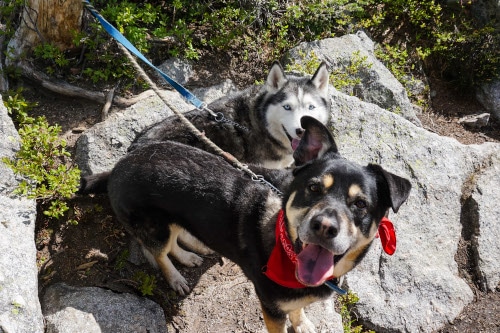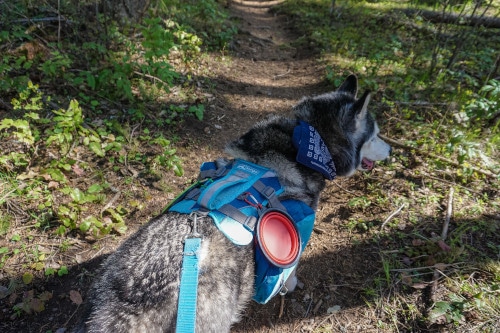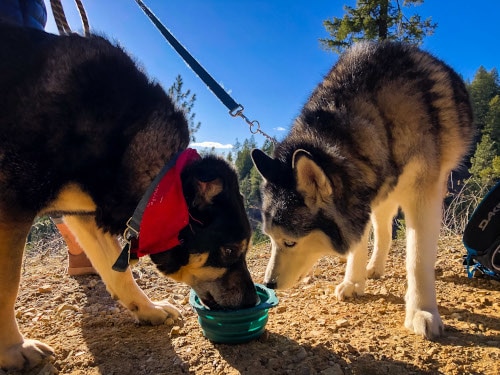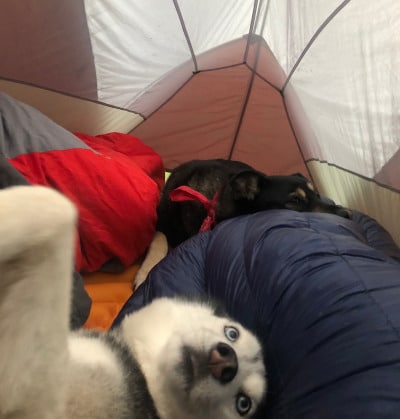Here at Two Trailbirds, we make it pretty well known that we love our dogs (Phoenix and Kota). They're fun, hilarious, and make our lives infinitely better. They also happen to share our love of hiking, so what better activity is there for us to do together than go backpacking?
Backpacking with dogs can be extremely enjoyable and rewarding, but it does come with it's own set of challenges. If you don't plan well before you go it can be pretty difficult for all involved. Through trial and error and a lot of research, we've figured out the best ways to make backpacking with a dog an awesome experience.
Note: As an Amazon associate I earn from qualifying purchases. If you click through one of the links on this page and make a purchase, we receive a small commission at no extra cost to you. It helps keep us up and running and able to continue to provide great content. 🙂
1. make sure your dog is up to it
As much as we want to take our dogs everywhere we go, it's important to consider whether or not they're capable enough to handle backpacking. There are a few different things to look out for here.
- Breed - Generally speaking, "squished-face" breeds like bulldogs and pugs have a harder time breathing and therefore aren't well-suited to strenuous activities. Small dogs can be good backpackers, but you'll need to be very cautious about not overworking them. Some of the best breeds are any kind of herding dog (Australian Shepherd, Blue Heeler, Border Collie), retrievers, and huskies(shout-out to Kota) because of their high endurance levels.
- Individual Health - Most large dog breeds can be very capable hiking partners, but be aware of their individual health. If your dog has any kind of respiratory condition, it's probably better to not risk it. Also be aware the some great hiking breeds like retrievers and Bernese Mountain Dogs are prone to hip conditions. Not all dogs in the breed have them, but they are common so make sure to check.
- Age - When you have a puppy you need to be careful to not push them. Young dogs have weaker bones and joints and strenuous activity can easily cause lifelong injuries. They often won't show any sign of damage until long after the cause, so just stay on the safe side. Keep strenuous activity to a minimum until they're 8-12 months old, depending on the maturity age of the breed.
2. Pick the right Trail
Once you know your dog can handle it, it's time to find a trail. Start by looking at your nearest chunk of National Forest, BLM land, or State Park for good trails, then make sure dogs are allowed there (they usually are). If you need help, hikewithyourdog.com is a cool resource that can help you find some "tail-friendly trails" in your state.
After you have a trail picked, evaluate it for good dog-friendly conditions. Some trails are perfect for dogs and some are really bad, but most will be a bit of a compromise. For the best trails, look for these qualities:
- Abundant water - Be mindful of water availability. A dry trail isn't a total deal-breaker, but remember that you'll have to carry water for both of you.
- Moderate temperatures - Dogs aren't nearly as efficient as humans are at regulating body heat, so be extra careful with temperature. That built in fur coat is great for the winter, but in summer it can be deadly. You should generally aim for temperatures of less than 70 degrees F. If it's any higher, plan on taking frequent rest and water breaks.
- Shade - Even when temperatures are moderate, desert sand or exposed flat rock can still get blisteringly hot. Although you can help your dog out with some booties, a trail with intermittent shade is a good idea.
- Forgiving trail surface - Dogs have some pretty tough feet, but they aren't invincible. Avoid extra jagged trails or trails made of sharp volcanic rocks.
Some others things to consider are whether or not there are wild animal concerns (rattlesnake country is a bad idea) and how popular the trail is. If your dog isn't great with other dogs (a problem those who rescue may be familiar with) then it'll be best to stick to the less popular trails.
3. Do some training
Before you go out for long distances, do some shorter training hikes with your dog (local state parks are great for this). Dogs benefit from conditioning just like humans do, so the more you can get them out with you the better. This will also help to get them used to behaving in a trail environment.
If you're not already pretty active with your dog, start with short hikes of 1-3 miles and see how they do. If they do well you can work up from there. For dogs who already get a good amount of exercise, getting them out on a trail with some elevation change will help prepare them even better. This process will also slowly toughen up their feet so they don't get hurt on trail.
4. Know how to control your dog

You might have the sweetest dog of all time, but if you can't prevent him/her from running up to another dog, person, or wild animal, then they need to be on a leash. Bears don't care how nice your dog is and neither do other dogs. The leash is for your dog's safety as well as everyone else's.
If you have a dog that's usually great off-leash, see if you can test them in some distracting scenarios. If they always come when you call them, then they can go off-leash on trails where leashes aren't explicitly required (they are in many places). Just make sure you still carry a leash and keep it handy for times when you need to pass other people (especially other people with dogs).
For really difficult dogs, it's also a good idea to bring some sort of lightweight stake that you can tie them off to. It's extra weight, but it's worth it to keep them safe. ID tags, microchips, and GPS collars are good to have as well for a worst case scenario.
5. Get your dog a backpack
You're not really backpacking with a dog unless they get to wear a backpack too, right? Get them a pack (we use a Kurgo Baxter for both of our dogs; full review here) so they can carry some of the extra stuff they need, like a tie-out stake, food, treats, and poop bags.

It's also super important to make sure you get a pack that fits right. Packs are sized based on the circumference of your dog's chest. Once you have the right size, put it on your dog and tighten all the straps so they're snug, but not too tight. It's a good idea to have them exercise a little before you put it on so that you can adjust the fit to the full expansion of their lungs.
Take them on a walk with the empty pack first to make sure there are no major issues, then start adding weight evenly on both sides. The maximum amount you can give a dog is about 20% of their body weight, but I don't think it's necessary to go over 15%. Dogs are tough, but since they can't really tell you when they're uncomfortable I like to stay on the safe side.
6. Get the rest of your dog's gear
Dog's don't obsess over gear like we do (something I could probably stand to learn from), but they need it nonetheless. Gear requirements vary by dog and trail, but here are some of the most common items:
- Booties - I'm not a big fan of booties as I think toughening up paws is better than breaking in shoes. There are some situations where you should use them, though (snow/ice, jagged rocks, hot sand).
- Water/food bowl - These come in a variety of types, but I like collapsible ones with carabiners (like these or these; we use both) for quick access.
- Small towel (microfiber is best for weight/absorbence ratio)- Easy to forget, but you'll kick yourself when you do. Dogs have a tendency to get dirty, so having something to wipe off their feet with before they get in the tent is great.
- Reflective vest - It's hard to believe that a hunter could mistake a dog for a wild animal, but it happens. If your dog isn't already wearing a bright pack a reflective vest is a good idea.
- First-aid - You're probably already carrying a first aid kit, so throw some dog specific items in there as well. Tweezers, nail clippers and foot salves can be especially useful.
- Cooling collar - These can be great for keeping your dog extra cool on hotter days.
7. learn how to provide proper nutrition
Just like your nutrition needs, your dog's nutrition needs will change while backpacking. They can usually just eat their regular food (wet food can get really heavy so use dry food if possible), they'll just need more of it. For short trips of 1-3 days, you should bring about 25% more per day than your dog usually eats. Any longer and you'll likely need to up it to 50% or more.
This is one of those things that requires a lot of tweaking, so err on the side of bringing more until you get it dialed. You may also want to look into getting higher quality and more calorie dense dog food for backpacking trips. We totally understand how crazy expensive the best dog foods can be, but for backpacking the reduced weight and better nutrition might be worth the expense. Dog Food Advisor is a great resource to help you pick a new food, and your vet can help you out as well.
Another good idea is to bring treats. Our dogs love hiking anyway, but it's nice to able to reward them for behaving on trail. Plus, there are a ton of good freeze dried options that are meat-only and ultralight (our dogs like these single ingredient training treats). Whatever routine you practice with treats at home, maintain it on trail.
8. Make sure your dog stays hydrated

Your dog can't tell you when they're thirsty, so give them water often. The best practice is just to give your dog an opportunity to drink whenever you stop to drink or snack. If you drink while walking (like we often do), you can give your dog a waterfall straight out of your water bottle every ten minutes or so (depending on temperature and pace).
For camp or when you stop for a snack, though, it's helpful to have a small collapsible dog bowl. That way your dog can drink as much as they need to and you'll waste a lot less water (if water is really scarce, just do this more often instead of waterfalling). Many, like the RUFF Barkbowl that we often use , have carabiners so you can clip them to your pack for easy access.
As for filtering, some say you should filter your dog's water and others say don't bother. Dogs can get giardia just like you can, but there is evidence to show that they are much less likely to have the severe adverse effects that most humans experience. It's also pretty tough to keep a thirsty dog from drinking from every stream and lake they come across, so it may not be a risk you can really manage. The biggest thing is to keep them from drinking from stagnant ponds or puddles. And if you're giving them some of your water, it certainly won't hurt for you to filter it.
9. protect them from insect pests
Giardia sucks, but it usually isn't a huge deal even for humans. What is a huge deal for everyone (including dogs) is Lyme Disease. If you're not already aware, Lyme Disease is a really nasty illness spread by ticks that can cause headaches, arthritis, extreme fatigue, and even kidney failure. It's important that both you and your dog are protected from it.
One cool thing about dogs is that while you can't spray DEET on them, you can 'treat' them with permethrin the same way you can treat your clothes. Permethrin is effective against mosquitoes and very effective against ticks, so this is the best way to protect them in tick country. Learn how to permethrin treat your dog here.
10. learn trail etiquette
Trail etiquette is different than usual when you have a dog and it's important to understand the differences. First and foremost, know your leash law and always abide by it. Although in my experience leash laws are rarely enforced, it's extremely disrespectful to other trail users if there are leash requirements in place and you don't abide by them. Everyone has a right to enjoy the trail.
Then there's yielding. Normally downhill hikers move off the trail for uphill hikers, but hikers with dogs always move off the trail for those without dogs, regardless of direction. When passing hikers both have dogs, the uphill rule applies again.
It's also important to note that unless your dog won't approach other people without your permission, it's common courtesy to hold their collar or clip them to a leash while others are passing, even if there are no leash laws. I personally love it when random dogs jump on me (because they're almost always just showing affection), but many people don't and we as dog owners need to respect that.
11. Make some room in the tent

Not everybody lets their dog sleep in their bed at home, but when you're backpacking make sure they have some room in your tent. They'll be much warmer and more often than not they'll need your immediate presence to feel comfortable sleeping in the woods.
In my experience if there isn't quite enough room for everybody, your dog will be just fine; it's you that will end up cramped. For the best nights sleep for all involved, size up your tent when you bring a dog along (1 person and 1 dog would use a 2-person tent, etc.). But 2 dogs (sometimes more) can fit in the space 1 person would, so no need for an XXL tent if you have more than one.
We have a Tarptent Stratospire (2 person tent), which has optional "sidecars" that add extra enclosed tent space into the vestibule. This is a unique tent and it's perfect for people with dogs. Another thing to keep in mind is that a lot of dogs like a bed to sleep on, so if that's the case bring along a closed-cell foam pad (or half of one) like a Therm-A-Rest Zlite.
11. Leave no trace
This doesn't necessarily mean you always have to pack out the inevitable dog poop, but follow the same rules you would for human waste. If it's an area where humans only use provided bathrooms, then pack it out. If it's a wilderness area or National Forest, bury it in a hole at least 6 inches deep and at least 200 feet away from water sources. Always leave the trail better than you found it.
Any questions or thoughts? Let me know in the comments!

Great information here, thanks for reminding me of some things I can forget.
I had no idea about Permethrin Insect Repellent! That was great and addresses a concern I had for the trail and to reinforce the treatment we have on them at home!
Thanks!
You’re welcome! I didn’t know until recently either, but it’s awesome. Works on their fur just like our clothes!